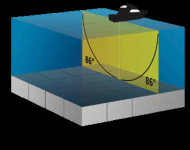That's interesting. I'm basing my discussion on Humminbird Side View. I know theirs goes nearly 180 degrees side to side. I can back that up with experience with my Helix Side Imaging.
I would be surprised if Garmin's didn't as well. When looking at that link, it isn't 100 percent clear to me if the chart isn't just refering to ClearVu. Here is another link to a Garmin Article that shows the beam width graphics for ClearVu and SideVu.
https://support.garmin.com/en-US/marine/faq/moH7wuZ0ySA8uVxEvxjcp8/
I'm going to definitely look into this more. I'm considering upgrading from my Helix 5 to a larger Garmin. Part of the decision is the availability of the mapping with Garmin (who acquired Navionics); so, they now include their basemaps.
Humminbird plays games with their performance specifications.
My biggest gripe is the use of non-industry standard units of measure, purposely making it hard to make a side by side comparison of performance.
Case in Point:
1. Output Power measured in Peak Power instead of RMS watts.
2. Beam coverage rated -10 dB instead of -3 dB.
Taken from Humminbird manual
Side Imaging
Operating Frequency .....................................455 kHz, 800 kHz,
Area of Coverage ...... 455 kHz: 86° @ -10 dB
800 kHz: 86° @ -10 dB
From my GT51-M-TM CHIRP transducer specification
Side Imaging
Operating Frequency ..........260 kHz (245-275 kHz), 455 kHz (445-465 kHz)
Area of Coverage ...... 245-275 kHz, 51° @ -3 dB
445-465 kHz, 29° @ -3 dB
The first thing I notice about both specifications is that 2 x "coverage" doesn't equal 180°.
The second thing I notice is the HB beams are rated at -10dB.....
Can't say with certainty w/o
Transmit Radiation Pattern data for this particular transducer, but generally speaking, the area of coverage at -10dB is roughly twice that of -3dB, making the HB roughly 43° at -3dB
The other thing I notice is that the beam width on the HB stayed the same at both frequencies. Beam width decreases as frequency increases.
What does all this tell us......neither can "array" 180° unless they use a third transducer to build a "mosaic of the area.
























